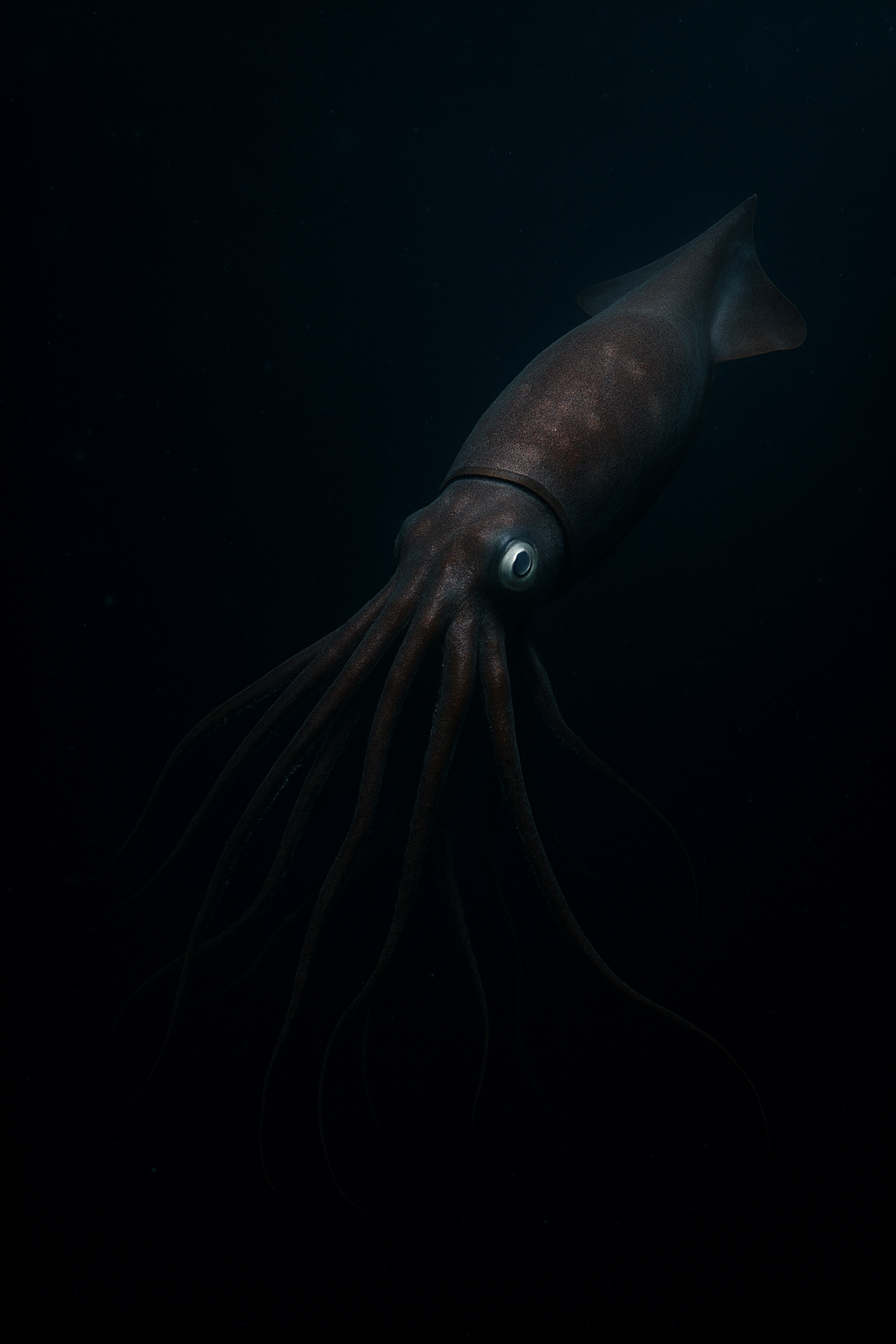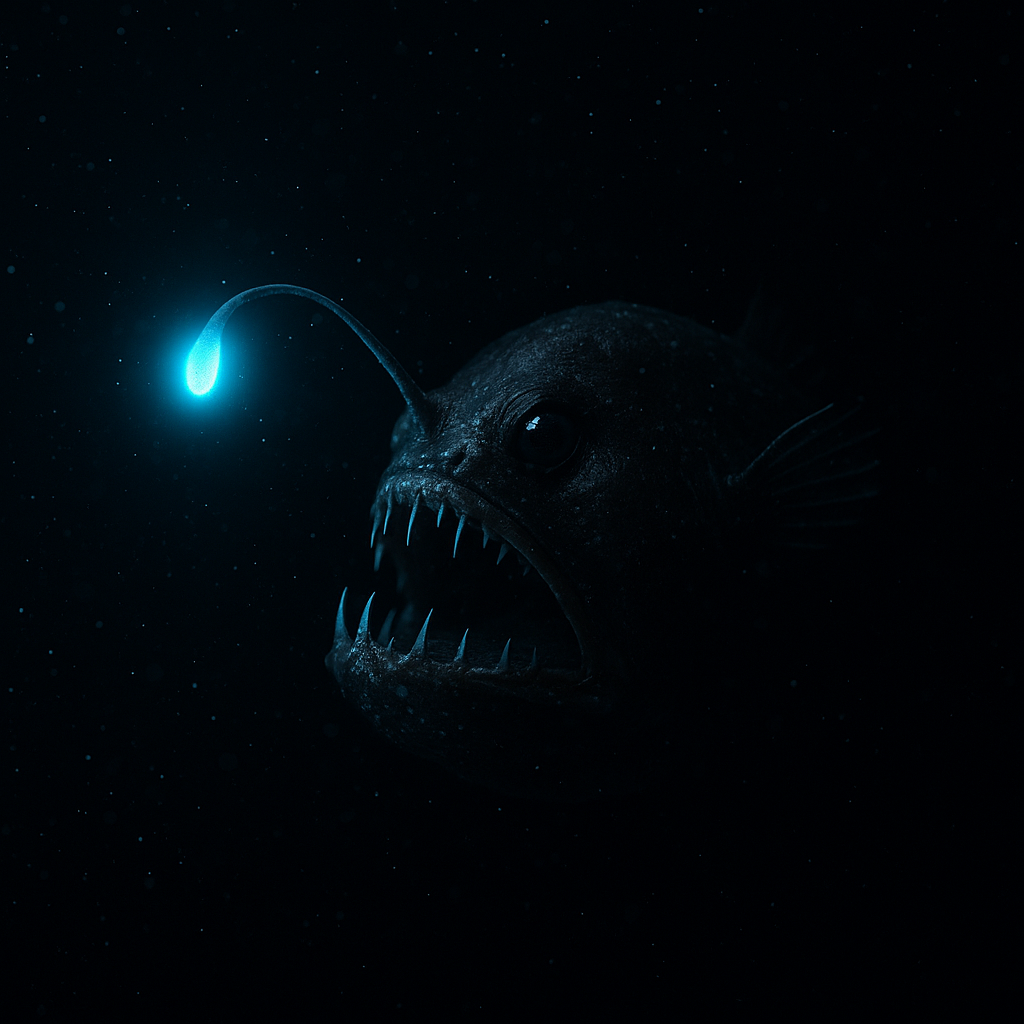Introduction – Into the Black
To enter the deep sea is to leave the known world behind. Beyond the reach of sunlight, past the rolling swells and the twilight waters where the last traces of blue fade, there is a descent into silence. The water grows cold, pressure builds, and the sense of scale dissolves into infinity. This is the midnight zone, a place of almost unimaginable darkness, where the ocean becomes as alien as another planet.

And yet, life thrives here. In these black waters, rare encounters take place: a flash of bioluminescence, a vast shadow gliding past, a creature so strange it challenges our understanding of evolution. For centuries, humans could only guess what inhabited the abyss, piecing together myths from carcasses washed ashore and half-seen shapes in the waves. Today, with submersibles and deep-sea cameras, we know a little more — but the abyss remains one of Earth’s greatest frontiers.
The Science of the Abyss
The deep sea covers more than 60% of the planet’s surface, making it the largest habitat on Earth. Yet less than 5% of it has been explored. To live here requires extraordinary adaptations to three fundamental challenges:
- Crushing Pressure – At 1,000 meters deep, pressure reaches 100 atmospheres — the equivalent of an elephant standing on your chest. Deep-sea creatures survive with flexible cell membranes and pressure-resistant proteins.
- Absolute Darkness – Beyond 200 meters, sunlight vanishes. Sight becomes nearly useless. Creatures rely on touch, smell, vibration, and light they generate themselves.
- Food Scarcity – Without photosynthesis, food falls from above as “marine snow”: flakes of dead plankton, fecal matter, and organic debris drifting downwards. Large animals rely on scavenging or rare ambushes of prey.
The abyss is a world of efficiency and patience. Life here moves slowly, conserving energy for the rare moment when opportunity strikes.
Adaptations Beyond Imagination
Deep-sea creatures have evolved forms so unusual they appear almost supernatural:
- Bioluminescence: Over 90% of deep-sea animals can produce light. Some, like the anglerfish, lure prey with glowing appendages. Others, like lanternfish, flash signals to communicate or hide in counter-illumination — glowing on their undersides to erase their shadows.
- Gigantism: Species like giant isopods, Japanese spider crabs, and colossal squids exhibit “deep-sea gigantism.” Slower metabolisms and fewer predators allow them to reach sizes unthinkable in shallow waters.
- Transparency: Many jellyfish, squid, and larval fish are nearly invisible. Transparency provides protection in a world where light is rare and predators hunt by silhouette.
- Red Pigment: Some creatures appear black because red light does not penetrate the deep. A blood-red shrimp is invisible to most eyes in the abyss.
These adaptations reveal an ecosystem tuned not for abundance, but for survival in scarcity.
Icons of the Abyss
The Giant Squid (Architeuthis dux)
Once a monster of legend, the giant squid is a reality stranger than myth. Growing up to 13 meters long, with tentacles armed with serrated suckers, it is among the most elusive animals on Earth. For centuries, only dead specimens gave hints of its existence, fueling the myth of the Kraken. The first live footage, captured in 2012, revealed a creature both graceful and ghostlike, pulsing through the water in silence.
The Anglerfish
Few creatures embody the alien nature of the abyss like the anglerfish. With a lure that glows like a false star, it waits motionless in the dark until prey swims close enough for a deadly strike. Stranger still is its reproductive strategy: the tiny male fuses permanently into the female, becoming little more than a living appendage, ensuring reproduction in a realm where encounters are vanishingly rare.
The Siphonophore
Among the longest lifeforms on Earth, siphonophores can stretch over 40 meters, longer than a blue whale. Yet they are not a single being but a colony of specialized units, each performing a role: feeding, reproduction, locomotion. They drift like living constellations, strands of bioluminescence glowing like galaxies in the abyss.
The Gulper Eel
With a mouth that can expand like a balloon, the gulper eel is built for the unexpected. Its huge jaws allow it to consume prey larger than itself, a vital adaptation in a world where food is rare and unpredictable. Its whip-like tail glows to attract prey into the void.

The Dumbo Octopus
Named for its ear-like fins, the Dumbo octopus is one of the deepest-dwelling cephalopods, living at depths of over 7,000 meters. Its gentle flapping makes it look whimsical, but its survival is anything but simple. It represents resilience in the harshest habitat on Earth.
Mythology of the Depths
Before science, myth filled the abyss. Rare glimpses of strange animals were interpreted through imagination:
- Kraken (Norse legend) – Likely inspired by giant squid, this monster was said to rise from the sea to devour entire ships.
- Leviathan (Biblical texts) – A symbol of chaos and divine opposition, Leviathan embodied the uncontrollable force of the deep.
- Umibōzu (Japanese folklore) – A sea spirit that would emerge suddenly, capping waves and sinking boats.
- Ketos (Greek mythology) – Sea serpents slain by heroes like Perseus, reflecting mankind’s struggle to impose order on the unknown.
The abyss became a canvas for humanity’s greatest fears: chaos, destruction, the unknown.
Modern Discoveries – The Frontier Within
The 20th century transformed our relationship with the abyss. In 1960, Jacques Piccard and Don Walsh descended in the Trieste to the Mariana Trench, the deepest part of the ocean. They saw life where none was expected. Since then, remotely operated vehicles (ROVs) have revealed glimpses of creatures never before imagined.
- 2004 – First photographs of a living giant squid in its natural habitat.
- 2012 – First video footage of the giant squid in the wild, filmed off Japan.
- 2019 – NOAA explorers captured video of a giant squid in the Gulf of Mexico.
- Every Year – Dozens of new species are described from the abyss — glowing sharks, gelatinous fish, and even animals with no clear relatives.
Despite these advances, over 80% of the ocean remains unmapped. The abyss is still Earth’s largest wilderness.
Cultural Symbolism of the Abyss
The deep sea resonates beyond biology — it is a metaphor woven into philosophy, psychology, and art.
- In literature, from Herman Melville’s Moby-Dick to Jules Verne’s 20,000 Leagues Under the Sea, the ocean represents both fascination and terror.
- In psychology, the abyss mirrors the unconscious mind, vast and unknowable, where hidden fears and desires drift like unseen creatures.
- In philosophy, thinkers like Nietzsche used the abyss as metaphor for confronting the infinite — to “gaze into the abyss” is to face the unknown within ourselves.
The abyss, then, is not just a place — it is an idea. It represents mystery, fear, humility, and the boundaries of human knowledge.
Conservation and Threats
Even this remote realm is under threat.
- Deep-sea mining aims to harvest metals from the ocean floor, yet risks destroying ecosystems that evolved over millions of years.
- Climate change alters ocean circulation, reduces oxygen, and warms waters even in the abyss.
- Plastic and toxins have been found in the stomachs of deep-sea creatures and in trenches deeper than Mount Everest is tall.
Protecting the abyss is not just about science. It is about preserving the planet’s last great wilderness, a realm that teaches us humility.
Philosophical Reflection – The Lessons of Rarity
Why do rare encounters with abyssal creatures move us so deeply? Perhaps because they remind us that life is not ours alone. These beings live in silence, in darkness, without ever knowing sunlight — yet they thrive.
To glimpse a giant squid, to see a flash of bioluminescence, is to witness another way of being, one that is both fragile and eternal. In their rarity lies their power. They remind us that mystery is not absence but presence, on its own terms.
Closing Scene – The Vanishing Light
Picture it: a submersible drifts in silence. The lights are dimmed. Ahead, a flicker of blue glows, then fades. From the black, a vast shape emerges — arms trailing, eyes like moons. A giant squid floats in stillness, then with a single pulse, vanishes back into shadow.
This is the truth of the abyss: it gives us only glimpses, never permanence. Its creatures remain elusive not because they hide from us, but because they belong to a world we cannot claim. The deep sea holds its secrets, and in doing so, it offers us its greatest gift: the reminder that mystery endures.


Reply